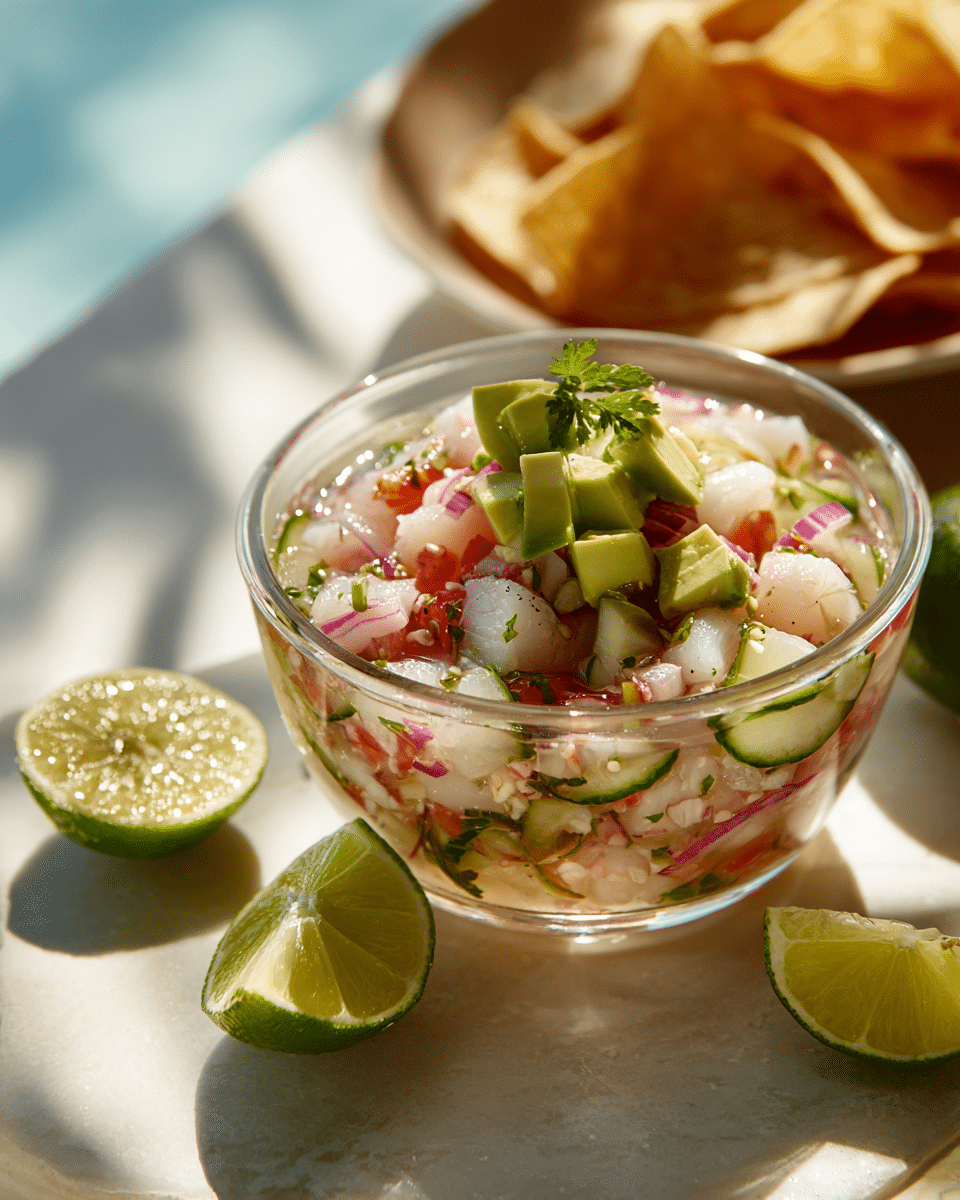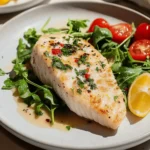Ceviche is a vibrant and refreshing Latin American dish made from raw fish cured in citrus juices, usually lime or lemon. Popular along coastal regions, this dish is bursting with flavor thanks to a mix of fresh herbs, spicy chili, and crisp vegetables. Often served chilled, ceviche is the ultimate warm-weather appetizer that showcases the simplicity and brilliance of fresh ingredients.
FULL RECIPE
Ingredients
- 1 lb fresh firm white fish (like snapper, sea bass, or halibut), diced into ½-inch cubes
- 1 cup freshly squeezed lime juice (about 8–10 limes)
- ½ cup freshly squeezed lemon juice (about 4–5 lemons)
- 1 small red onion, finely sliced
- 1–2 fresh jalapeños or serrano peppers, thinly sliced (optional for heat)
- 1 cup diced ripe tomatoes
- 1 cup chopped fresh cilantro
- 1 cucumber, peeled, seeded, and diced
- Salt, to taste
- Freshly ground black pepper, to taste
- 1 ripe avocado, diced (optional)
- Tortilla chips or tostadas, for serving (optional)
Directions
- In a large glass or ceramic bowl, combine the diced fish with the lime and lemon juices. Stir to coat evenly.
- Cover and refrigerate for 30 minutes to 1 hour, stirring once or twice, until the fish becomes opaque and firm—this indicates it has “cooked” in the citrus juice.
- Drain off about half of the citrus juice to avoid overpowering acidity.
- Add the red onion, jalapeños (if using), diced tomatoes, cucumber, and cilantro to the marinated fish. Stir gently to combine.
- Season with salt and pepper to taste. Adjust lime or lemon juice if needed for brightness.
- Gently fold in the diced avocado just before serving, if desired.
- Serve chilled with tortilla chips or atop crisp tostadas.
Nutrition Facts
- Calories: 190
- Protein: 24g
- Total Fat: 7g
- Saturated Fat: 1g
- Carbohydrates: 10g
- Fiber: 4g
- Sugars: 2g
- Sodium: 300mg
- Cholesterol: 40mg
- Vitamin C: 80% DV
- Vitamin A: 15% DV
- Iron: 8% DV
- Calcium: 4% DV
The Cultural Origins of Ceviche
Ceviche is a dish with deep roots in Latin American coastal cultures, particularly in Peru, Ecuador, and Mexico. It reflects a culinary tradition that celebrates fresh seafood and the abundant citrus fruits native to these regions. Historically, indigenous peoples used citrus juices to “cook” raw fish long before the arrival of Europeans. Over time, ceviche has evolved into many regional varieties, each with its own unique blend of flavors and ingredients, making it a culinary symbol of coastal life and culture.
Health Benefits of Ceviche
Ceviche is not only delicious but also highly nutritious. Made primarily from raw fish, it is an excellent source of lean protein, which is essential for muscle repair and overall body function. The citrus juice used to marinate the fish provides a hefty dose of vitamin C, a powerful antioxidant that supports immune health and skin vitality. Additionally, the fresh vegetables and herbs commonly added to ceviche contribute fiber, vitamins, and minerals, making it a light, healthful dish with few calories and healthy fats.
Types of Fish and Seafood Used
The choice of fish or seafood is fundamental to a great ceviche. White, firm-fleshed fish like snapper, sea bass, or halibut are preferred because they hold their texture well when cured. However, ceviche is highly versatile; shrimp, scallops, squid, or even mixed seafood combinations can be used. The freshness of the seafood is critical, as the curing process doesn’t involve heat, so only the highest quality, sushi-grade seafood should be selected to ensure safety and optimal flavor.
The Role of Citrus in Ceviche
Citrus juice is the heart of ceviche, functioning as the “cooking” agent. The acidity denatures the proteins in the fish, changing its texture and color to resemble that of cooked seafood. Lime and lemon juices are most common due to their bright, sharp acidity, but some recipes incorporate orange or grapefruit juice to add subtle sweetness and complexity. The balance between acidity and other flavor elements is key to achieving a perfect ceviche that is both tangy and refreshing.
Common Flavor Enhancements
Beyond citrus and seafood, ceviche often includes ingredients that add layers of flavor and texture. Onions, especially red onions, contribute a pungent crunch, while fresh cilantro adds herbal brightness. Chili peppers introduce varying levels of heat, which can be adjusted to personal preference. Other additions like tomatoes, avocado, and cucumber provide fresh, juicy contrast. These elements come together to create a harmonious balance of sour, spicy, salty, and fresh tastes.
Regional Variations
Ceviche takes many forms depending on geographic location. In Peru, ceviche typically features a simple marinade of lime juice, chili, and salt, often served with corn and sweet potato. Ecuadorian ceviche often includes tomato sauce and uses shrimp rather than fish. Mexican versions might include diced avocado and are served with crunchy tortilla chips. Each regional adaptation reflects local ingredients and cultural tastes, showcasing the dish’s versatility and wide appeal.
Serving Suggestions
Ceviche is best served chilled and fresh, making it an ideal appetizer or light meal on warm days. It pairs wonderfully with crisp tortilla chips, tostadas, or even alongside a fresh green salad. Many enjoy it with a cold beer or a refreshing cocktail such as a margarita or pisco sour, which complement the citrusy, zesty flavors. For a more substantial meal, ceviche can be served atop rice or wrapped in corn tortillas as tacos.
Storage and Safety Tips
Since ceviche is made from raw fish cured in citrus juice, it should be consumed relatively quickly to ensure freshness and safety. Ideally, it should be eaten within a few hours of preparation and kept refrigerated until serving. Extended storage can cause the fish to become overly acidic and mushy. It’s important to use the freshest fish possible and proper hygiene to minimize the risk of foodborne illness.
Variations for Dietary Preferences
Ceviche is naturally gluten-free, dairy-free, and low in carbohydrates, making it suitable for many dietary lifestyles, including paleo and keto diets. For those who avoid seafood, creative variations include using mushrooms, hearts of palm, or even watermelon, which mimic the texture and absorb citrus flavors well. Spices and herbs can be tailored to individual tastes, allowing for a personalized and healthful twist on the classic dish.
Pairing Ceviche with Other Dishes
Because of its bright and fresh flavor profile, ceviche pairs well with other light, complementary dishes. It works as a starter before grilled meats, seafood, or spicy Latin American dishes. Side dishes such as black beans, rice, or plantains balance the acidity with mild sweetness or earthiness. For beverages, crisp white wines, sparkling wines, or cocktails with citrus notes enhance the overall dining experience.
Conclusion
Ceviche is a timeless dish that captures the essence of coastal cuisine with its fresh, vibrant flavors and simple preparation. Its cultural significance, health benefits, and adaptability make it a favorite worldwide. Whether enjoyed traditionally or with modern twists, ceviche offers a refreshing and nutritious way to savor the bounty of the sea, perfectly suited for warm days or any occasion that calls for a zesty, light appetizer.






